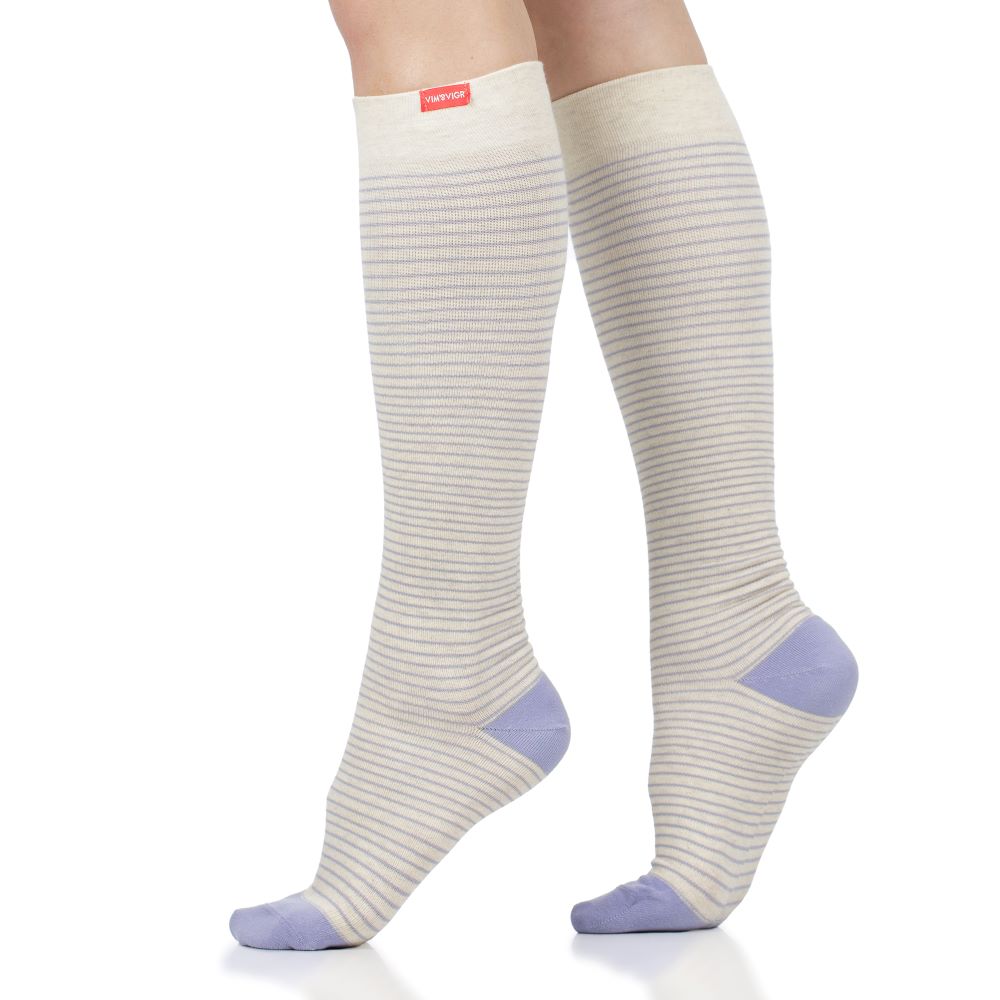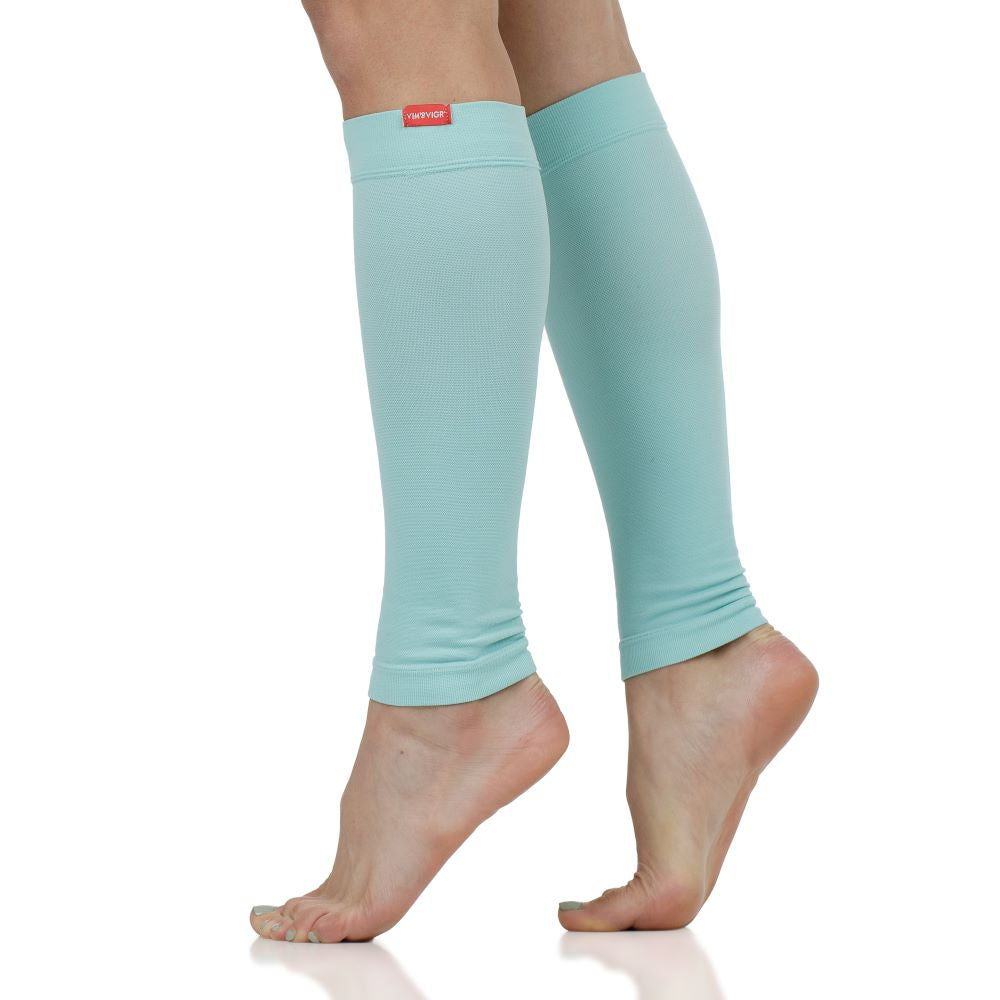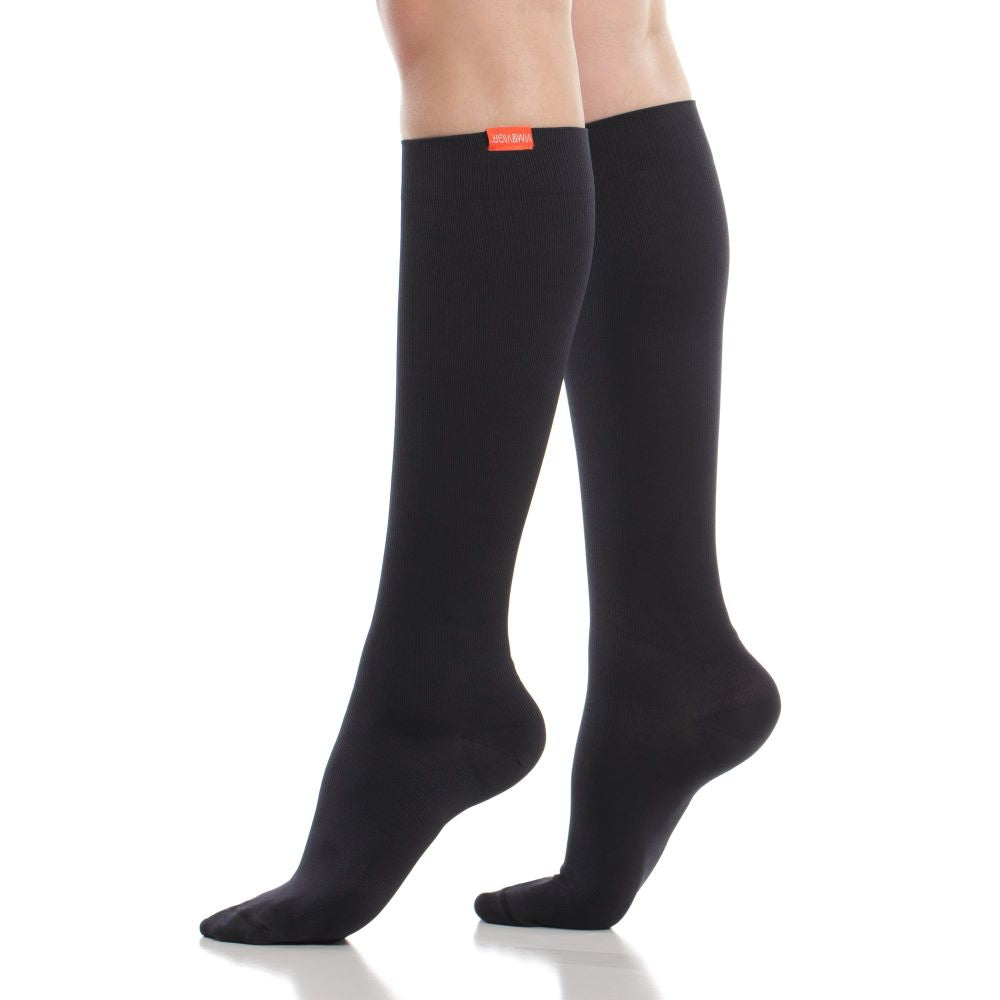Should I Wear Compression Socks While Walking?
Walking is a fantastic way to stay fit, keep a healthy weight at any age, and get mental health benefits, all while enjoying the beautiful outdoors. But just like with any sport, walking can put strain on the body. The strain can be significant if you’re recovering from an injury (for example, an ankle sprain) or if you’re hiking or walking long-distances. Even shorter walks can be challenging if you don’t have the right footwear!
Compression socks help keep your feet healthy and happy for any length of walks. Their therapeutic pressure supports your peripheral circulation, helps you avoid swelling and discomfort, and protects your joints and ligaments. And wearing the right socks can have more benefits, such as protection from blisters or moisture wicking.
Read on to find out why you should wear compression socks or stockings while walking. We’ve also answered all your frequent questions about choosing the right pair for you.
Should I Wear Compression Socks While Walking?
Yes, wearing compression socks while walking can yield multiple benefits. Researchers have found that leg compression improves blood flow in the lower legs while you walk, which reduces the risk of swelling and discomfort. This boost in circulation is particularly important if you suffer from conditions like venous insufficiency or varicose veins. In these cases, compression socks make it easier and pain-free to enjoy exercising outdoors. Through their design and functionality, compression socks and stockings provide extra benefits that make them a top choice for hikers and athletes. These include reduced friction, support for flat feet or weaker ankles, moisture wicking, and more.
The Benefits of Wearing Compression Socks While Walking
Thanks to the therapeutic pressure that graduated compression socks apply to the lower legs, they boost peripheral circulation and energize and revitalize the legs, according to a major research study. This action also reduces swelling and discomfort, while the tight grip on the leg muscles can also feel particularly reassuring and supportive.
Improved Blood Circulation
By applying more pressure at the lower end of the legs and slowly decreasing as they climb towards the knee, graduated compression socks stimulate blood flow upwards. This reduces the risk of blood pooling around the ankles to cause swelling or blood clots.
Better blood flow may help you feel more energized and ward off fatigue when you spend long times on your feet.
Discover our range of everyday wear compression socks.

Muscle Support and Injury Prevention
As compression socks tend to have a firm hold on the joints and muscles in the lower legs, they provide added support that regular footwear simply does not. One research study found that compression socks can improve your lower leg stability while moving, which could reduce your injury risk. Also, a well-fitted pair of compression socks can be soothing and supportive of the calf muscles to help keep the ankles and Achilles’ tendons protected.
This support does two things. First, supporting the muscles can reduce the pressures from repeatedly landing on firm ground (especially important for walking on hard surfaces like roads). Second, better support of your joints and muscles reduces the risk of injury while you walk.
Reduced Swelling and Fatigue
Scientific research indicates that walking while wearing compression socks is a good remedy for people suffering from edema. Through the therapeutic pressure they apply on the lower legs, compression socks were found to help reduce swelling and prevent conditions like lymphedema (where the lymphatic liquid doesn’t drain properly through the body).
Moreover, by massaging the leg muscles and reducing fluid buildup in the legs, compression socks improve the overall wellbeing of people while they walk.
Reduced Friction
One of the biggest sources of discomfort that happens when walking is the development of blisters or sore, irritated skin. This happens because of friction between the feet and the socks or against the walking shoes (which is why it is very important to wear appropriate, well-fitted footwear). Compression socks are tight-fitting and support the feet, too, reducing the risk of rubbing and chafing.
Moisture-Wicking Properties
Finally, choosing the right material for your socks can prove crucial in feeling more comfortable and warding off injuries and irritation. Merino wool is known to provide all-weather breathability and softness. It keeps feet dry and warm, but also lets in enough air to keep you cool on warmer days.
Additionally, merino wool is hypoallergenic and antibacterial - giving walkers extra protection from infections and irritation.
Explore our moisture-wicking merino wool socks for hikers
Who Should Consider Wearing Compression Socks While Walking?
The question you may be asking is, “Do I really need compression socks to go walking?” Of course, the short answer is, “Maybe.” It all depends on your physical condition, walking plans, health condition, and personal preference. But if you asked us, “Should I wear compression socks while walking?” Our answer is, “Yes.” As we discussed earlier, there are a wide variety of benefits that come from wearing compression socks while walking. Compression socks can be beneficial to anyone while they walk, regardless of age, fitness, or health situation. Here are some more common cases where we recommend wearing compression socks.

Older Adults
There is a tendency for our peripheral circulation to worsen with age, particularly if we’ve put noticeable strain on our venous system or have developed medical conditions throughout our lives. Older adults often suffer from conditions like varicose veins, among others. For aging adults, compression socks offer added support and pain relief during walks, also reducing the risk of any condition being made worse.
Fitness and Speed Walkers
Athletes swear by compression socks for enhanced performance and recovery due to their muscle support and circulation boost. Fitness enthusiasts will notice shorter recovery times when wearing compression socks after a walk, as better blood flow delivers nutrients and oxygen to the muscles more effectively, helping them recover. Additionally, wearing compression socks during walks helps support your muscles and joints to reduce the risk of injury.
For those walking for fitness, compression socks made from nylon or merino wool also provide flexibility, moisture wicking, and excellent temperature regulation.
Try nylon socks for fitness activities.
Walkers with Certain Medical Conditions
Although walking is an excellent form of exercise with relatively lower risk of injury, it can become painful for those with circulatory problems. Patients suffering from peripheral artery disease or diabetic neuropathy can experience extreme pain while walking. For these situations, especially if the pain is caused by cramping or swelling due to insufficient venous return, compression socks can significantly reduce pain and help you enjoy walking again.
Also, if you have had any ankle injuries in the past, a scientific study found that lower leg compression garments can improve your ankle function while walking. In that study, people reported that their quality of life improved from using compression stockings while walking.
Is it Safe to Wear Compression Stockings While Walking for Extended Periods?
Compression socks are safe to wear as long as you feel comfortable. However, we recommend easing the feeling of therapeutic pressure on your legs - lower leg pressure may not be for everyone, especially not right away!
Once you’ve bought your first pair of compression socks, wear them for 2-3 hours at a time, then gradually increase the time you keep them on. Listen to your body and remove your socks if they become uncomfortable (although well-fitting socks should be fine to wear for 24 hours if you wish to do so).

Can Compression Socks Speed Recovery After Speed Walking?
Yes, scientific research has found that compression socks can help reduce recovery time in between athletic efforts. Through the blood flow boost they give to your lower legs, compression socks help deliver oxygen and nutrients to the muscles more efficiently. This means that they can recover quicker, and that soreness should decrease, allowing you to go out on your next walk sooner.
Additionally, increased localized blood flow contributes to reducing inflammation and swelling - another key way to speed up your recovery after long walks.
How to Choose the Right Compression Socks for Walking
The most important element of ensuring your walking compression socks will deliver all the benefits you’re hoping for is making sure they fit you correctly. This means sizing and material are important, and - of course - the level of pressure they apply to your legs.
Understanding Compression Levels & Graduated Compression
All compression socks should feel tight, but there are different levels of pressure. Starting with 15-20 mmHg, which is appropriate for all-day wear, is a good idea for beginners and people who don’t suffer from any circulatory problems.
If you have varicose veins or are at risk of getting blood clots, you should discuss with a medical professional and consider the increased pressure of 20-30 mmHg socks. Finally, when recovering from surgery or if you have deeper medical issues, you could get a prescription for 30-40 mmHg socks.
Material and Size Considerations
Walkers need comfortable socks that can withstand the elements and keep their feet dry. Compression socks come in a variety of materials to support athletic activities, which is an added bonus along with the boost in blood flow:
- Moisture-wick nylon is soft, sleek, and wicks away moisture effectively;
- Merino wool is great for temperature regulation and moisture-wicking, while also providing antibacterial and hypoallergenic benefits;
- Choice nylon is super soft and has no toe seam, for less risk of rubbing.
To get the right size of socks, we advise measuring the circumference of your calf and then plotting that against our sizing chart here.
Where to Buy Compression Socks for Walking
Many specialty fitness or outdoor shops will carry some socks for walking along with their running range, which can be a good opportunity for you to try on some pairs. However, for the full range of designs, materials, sizes, and compression levels, purchasing from our website gives you all the choice and information you need. You can also find more useful information about how to use your socks, how to make the most of compression depending on your activity, and extra health advice on our blog. Finally, check our store locator to find where our socks are in stock countrywide.
References
Ibegbuna, V., Delis, K. T., Nicolaides, A. N., & Aina, O. (2003). Effect of elastic compression stockings on venous hemodynamics during walking. Journal of vascular surgery, 37(2), 420–425. Read it here.
Sultan, M. J., Zhing, T., Morris, J., Kurdy, N., & McCollum, C. N. (2014). Compression stockings in the management of fractures of the ankle: a randomised controlled trial. The bone & joint journal, 96-B(8), 1062–1069. Read it here.
Lim, C. S., & Davies, A. H. (2014). Graduated compression stockings. CMAJ : Canadian Medical Association journal = journal de l'Association medicale canadienne, 186(10), E391–E398. Read it here.
Barufi, S., Pereira de Godoy, H. J., Pereira de Godoy, J. M., & Guerreiro Godoy, M. F. (2021). Exercising and Compression Mechanism in the Treatment of Lymphedema. Cureus, 13(7), e16121. Read it here.
Ema Quilici Belczak, C., Pereira De Godoy, J. M., Quilici Belzack, S., Andréia De Moraes Silva, M., & Caffaro, R. A. (2012). Compression stockings have a synergistic effect with walking in the late afternoon to reduce edema of the lower limbs. International angiology : a journal of the International Union of Angiology, 31(5), 490–493. Read it here.
Harvard Health. 2022. “When Walking Makes Your Legs Hurt.” Harvard Health Publishing. Read it here.





















Leave a comment